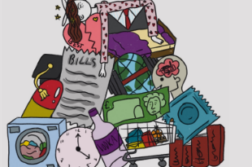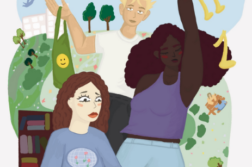Lockdown has given some of us the opportunity to expand our knowledge and find new hobbies. Whether this is learning a new language, an instrument, or even finally getting into that show you have always been meaning to watch (I would definitely recommend ‘New Girl’). It has especially caused our creative aspects to thrive, which has been supported by the existence of social media.
Tie dye is a technique used to dye clothes, which is very familiar to all of us. It faced a boom in popularity during the 1960s-70s, and was a staple of that era. With one-of-a-kind pieces being produced, the tie dye technique is a form of artistic expression. Although you may immediately think of the bold, vibrant, colourful examples, tie dye can have a colour palette ranging from tans to rainbows, making it extremely versatile.
In recent years, tie dye has made a comeback. In particular, 2020 has allowed us to express our creativity, with lockdown giving us no choice but to entertain ourselves somehow. The burst in artistic activities has been widespread. With various video tutorials on TikTok and an increase in lockdown fashion posts on Instagram, people have been inspired to have a go at tie dyeing, or to add more tie dyed pieces to their wardrobes.
Not only can it be a stress reliever and purely a form of artistic expression, it has also been commercialised. The existence of online marketplace apps, such as Depop, has given the opportunity for people to sell their pieces. This has been beneficial for those who had perhaps been hindered financially by the pandemic, as well as being a chance for artists to gain the recognition they deserve for their pieces. However, this method has also been exploited by fast fashion companies, with big name companies mass producing in-trend pieces, such as two-piece tie dye outfits. This clothing is produced using unsustainable methods, harming the environment, as well as their workers. I feel that people should utilise apps such as Depop a lot more, as not only is it advantageous for the seller, but eases the buyer’s mind that they are shopping sustainably and helping the environment. It places this money into small businesses that practice eco-friendly, non-exploitative methods.
Of course, we cannot ignore the fact that the tie dye trend never really ‘disappeared’ as such: it has purely risen in popularity over the past few months. Not only is it, as previously mentioned, a recurring part of fast fashion, but it is also used in an eco-friendly manner, whilst promoting sustainability. The appeal of this trend is how accessible it is, with supplies being used that most people would have at home – string, dye, and an article of clothing. It is not exclusively an artistic, fun pastime, but can also be a way of upcycling clothes that would normally perhaps be dismissed in your wardrobe, or thrown out. This in itself promotes the protection of the environment, with a reduction in waste.
With less restrictions being placed on the public in regards to going out, this has lead to new rules. For instance, the use of masks has allowed fashion brands to utilise this to their advantage. People may choose to wear trendy face coverings, giving them a chance to make a stylistic impression. In particular, bold, vibrant masks are being produced and used by members of the public, including the use of tie dye. Whilst they may be mass-produced by big retailers, there has also been a resurgence in the use of Etsy, with members of the public hand-making and selling their own face masks. This, as aforementioned, not only helps to promote environmental friendliness, but also is a great way to support local businesses who may have been harmed by the pandemic.
When considering the concept of tie dye making a ‘comeback’, I think it is important to consider how the trend never truly left. Instead, it has not been in the limelight for a while, and lockdown has caused a resurgence in its popularity. Tie dyeing allows an opportunity for expression, with no boundaries for creativity. Most importantly, it is considerably environmentally friendly, compared to other forms of fashion that are mass-produced.



